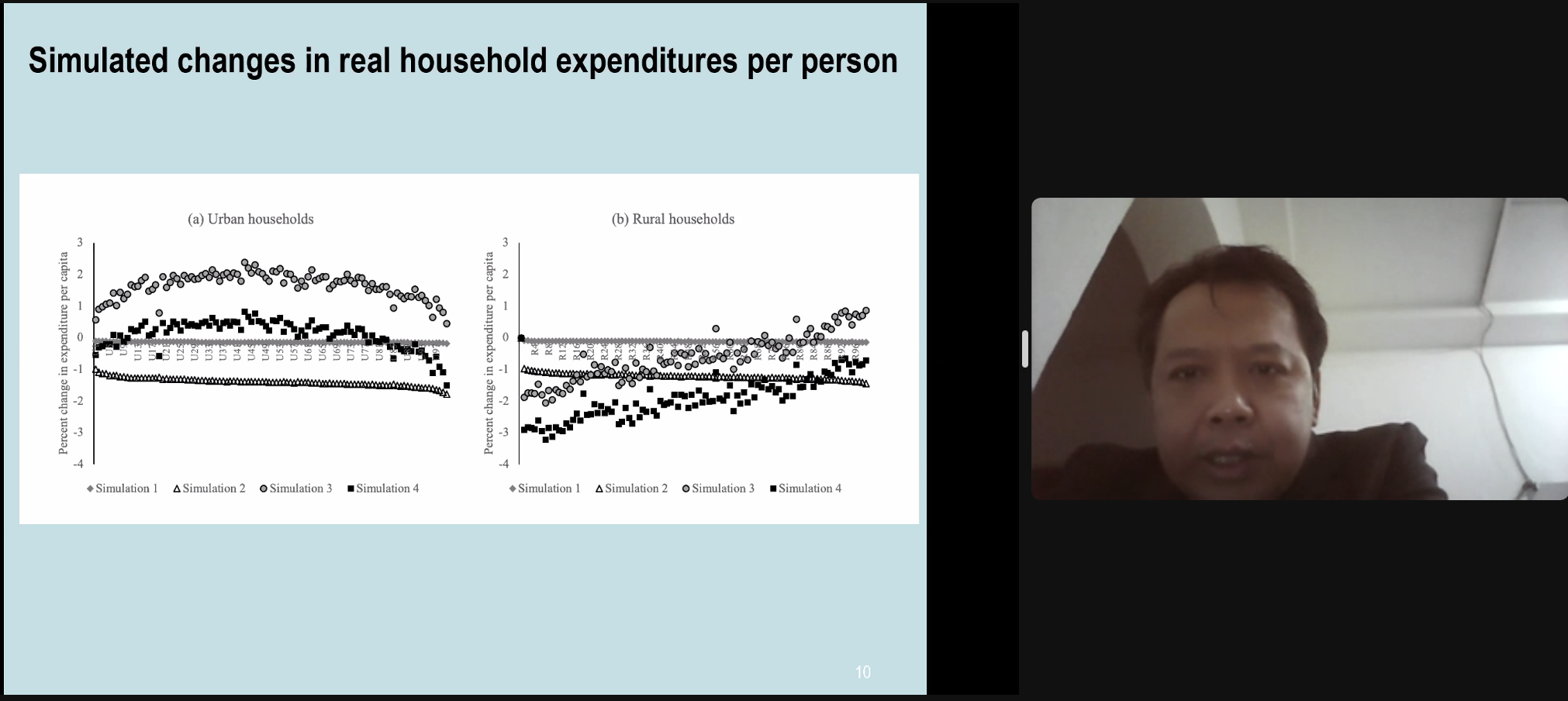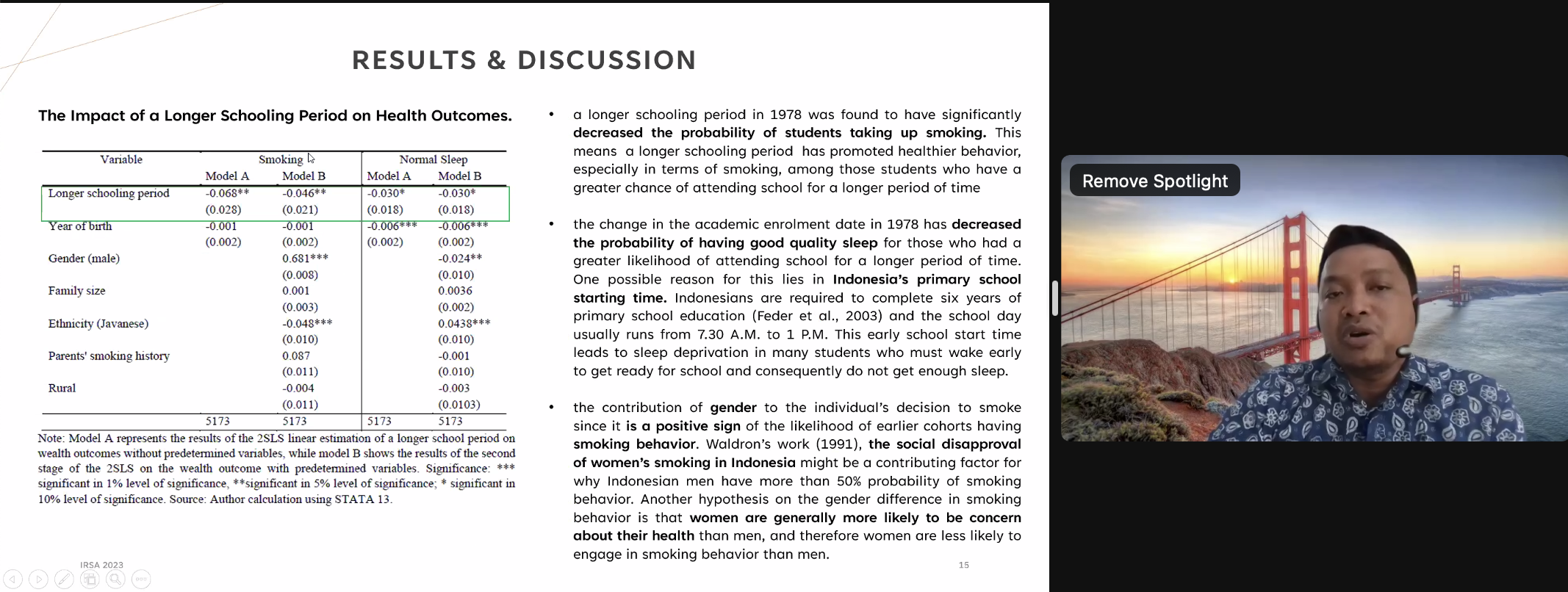FKP hosted by IRSA with Arief Anshory Yusuf (Universitas Padjadjaran), Peter Warr (ANU), Muhammad Syaikh Rohman (Universitas Airlangga), Achmad Rifa’i (BAPPENAS and Learning-Up Institute), Doddy Purwoharyono (BAPPENAS), and Muhamad Fickri Ramadhan (BAPPENAS). Friday, 28 July 2023
KEY POINTS:
- The study conducted by Arief Anshory Yusuf and Peter Warr highlights the severe impact of the COVID-19 pandemic on Indonesia, leading to a significant migration of people from urban areas to rural regions (de-urbanization). The loss of urban jobs compelled workers to take any available job to sustain their livelihoods, resulting in a shift in labor categories towards unskilled labor. Contrary to common belief, the negative economic impact of the pandemic was most pronounced among rural households, especially the poorest, indicating that the impact on rural households might be more severe than commonly perceived.
- M. Syaikh Rohman’s research examines the impact of a change in the school enrollment policy in 1978, resulting in a longer schooling period. It found that a longer schooling period reduced the likelihood of students taking up smoking, promoting healthier behavior. However, it also led to a decreased probability of students being employed in the formal job sector. The increase in employment rate in the urban and rural informal sectors during the 70s and 80s might explain this phenomenon.
- The study by Achmad Rifa’i, Doddy Purwoharyono, and Muhamad Fickri Ramadhan investigates the effects of Indonesia’s nickel export moratorium in 2020 to promote the development of a nickel downstream ecosystem. The study shows that the policy may have a positive effect on the GDP at both the national and regional levels, with Sulawesi benefiting the most. The iron and steel sector will experience substantial growth across all regions, indicating that the nickel downstream policy effectively stimulate economic progress both at the regional and sectoral levels, contributing to overall national economic growth.
SUMMARY
- Arief Anshory Yusuf, from Universitas Padjadjaran, conducted a study on the pandemic-induced de-urbanisation in Indonesia, focusing on the severe impact of the COVID-19 pandemic on the country. Initially, the pandemic was primarily centered in urban areas, but it led to a significant migration of people from cities to rural regions due to the loss of urban jobs, a phenomenon termed “de-urbanisation.” Update December 2023: the study is published in The Developing Economies journal (link).
- In his Computable General Equilibrium (CGE) model, labor was categorized into four groups: unskilled farm labor (employed only in agriculture), partly-skilled labor, semi-skilled labor, and skilled labor. Surprisingly, in 2020, there was only a 0.2 percent reduction in employment during the pandemic. This unexpected outcome was attributed to the fact that Indonesian workers were compelled to take any available job to sustain their livelihoods. Consequently, there was a significant shift in labor categories, with unskilled labor increasing from 35.5 percent in August 2019 to 38.2 percent during the mid-pandemic period.
- Based on the analysis of the Labor Force Survey (Sakernas) data, it was revealed that when accounting for de-urbanisation, the negative economic impact of the pandemic was most pronounced among rural households, especially the poorest. This finding contrasted with the common belief that urban households were more affected by COVID-19. The study shed light on the labor market effects of the pandemic, showing a substantial but temporary movement of workers from urban to rural employment. As these workers sought rural employment opportunities, they had to compete with existing unskilled rural workers, leading to a decline in rural wages and an increase in rural poverty incidence. Consequently, a significant portion of the economic hardships caused by the pandemic shifted from urban to rural households.
- These findings carry significant implications for social protection policy, as they indicate that the impact on rural households might be more severe than commonly perceived. The agricultural sector in Indonesia, which has traditionally served as an economic ‘shock absorber,’ could be facing a decline in its capacity to do so. This is mainly attributed to the decreasing share of employment in agriculture and the rise of mechanization, leading to a potentially less responsive demand for agricultural labor.
- M. Syaikh Rohman, a researcher from FEB Unair, conducted a study on the effects of a prolonged period of schooling on both health and wealth outcomes. The study focused on the changes in the enrollment policy in 1978, which led to longer schooling periods. It analyzed the impact of this policy on students’ health and wealth outcomes when they reached adulthood, 15 years later.
- Before 1979, the school enrollment process took place at the beginning of January. However, this policy was modified by Daoed Joesoef, the Minister of Education and Culture, who moved the enrollment date from January 1978 to July 1978. As a result, students who had enrolled in January 1978 were required to repeat a grade. Instead of completing their current grade in December 1978, these pupils remained in the same grade from July 1978 until June 1979.
- The study found that a longer schooling period in 1978 significantly reduced the likelihood of students taking up smoking. This indicates that an extended duration of schooling promoted healthier behavior, particularly in terms of smoking, among students who had the opportunity to attend school for a longer period of time. However, the same policy was associated with a decreased probability of students having good quality sleep.
- Interestingly, the reform of the school enrollment date had no discernible impact on students’ future income. However, it did result in a decrease in the probability of students being employed in the formal job sector. One plausible explanation for this phenomenon is the substantial increase in the employment rate in the urban and rural informal sectors during the 70s and 80s.
- A study conducted by Achmad Rifa’i, Doddy Purwoharyono, and Muhamad Fickri Ramadhan from Bappenas examines the economic impacts of Indonesia’s natural resource downstream policy, specifically focusing on the nickel moratorium. Indonesia, possessing one of the world’s largest nickel reserves (approximately 21 million metric tons in 2021), accounted for approximately 37% of global nickel production. However, before 2020, the country primarily exported low-value nickel ore. In response, Indonesia implemented a nickel export moratorium in 2020 to promote the development of a nickel downstream ecosystem and increase the value-added of its nickel exports. This study investigates the effects of this policy on the Indonesian economy.
- This study reveals that the nickel downstream policy has a positive effect on the GDP at both the national and regional levels, albeit with a relatively small impact. Among the regions, Sulawesi benefits the most from this policy, experiencing significant improvements in various macroeconomic indicators such as GDP, exports, investments, wages, and employment levels compared to other regions. Additionally, other regions also observe positive developments in their macroeconomic indicators, influenced by the spill-over effect of the nickel downstream policy, although the extent of these improvements varies across regions. At the sectoral level, the policy’s influence is evident in sectors like iron and steel, as well as other sectors due to the spill-over effect.
- The iron and steel sector stands out as the most notable gainer compared to other sectors, showing substantial growth across all regions. Specifically, Sulawesi experiences the highest surge in the output of the iron and steel sector. Furthermore, the construction and utilities sectors also witness significant advancements in Sulawesi. These findings strongly indicate that the nickel downstream policy effectively stimulates economic progress both at the regional and sectoral levels, consequently contributing to overall national economic growth.






